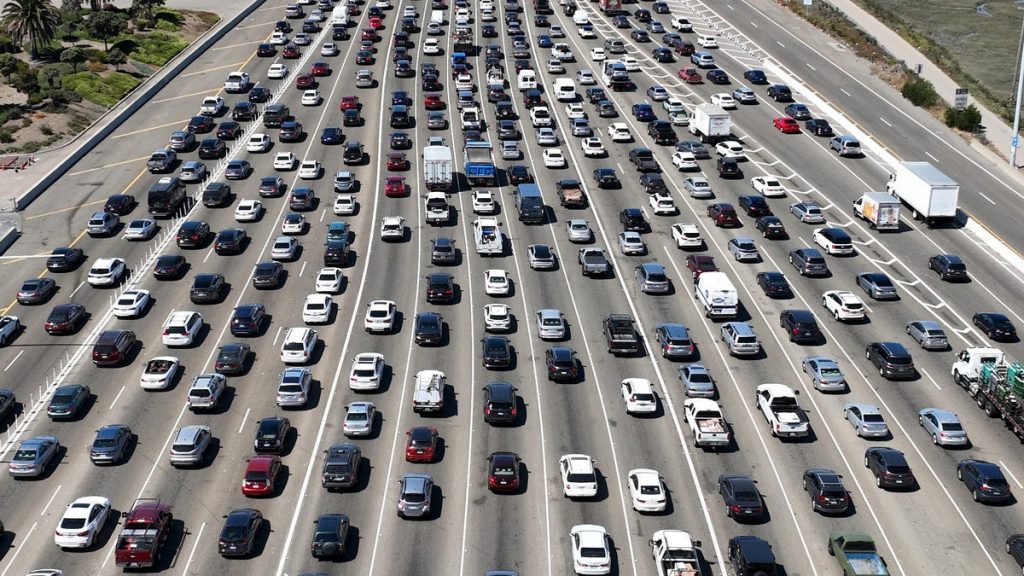California's Incentive Programs for Low-Income EV Buyers Must Expand to Meet Low Emissions Goals

OAKLAND, CALIFORNIA – AUGUST 24: Traffic backs up at the San Francisco-Oakland Bay Bridge toll plaza on August 24, 2022 in Oakland, California. California is set to implement a plan to prohibit the sale of new gasoline-powered cars in the state by 2035 in an effort to fight climate change by transitioning to electric vehicles. Photo: Justin Sullivan (Getty Images)
Electric vehicles are the future, but the thing about the future is, it often forgets the folks on the lower rungs of society. With the soaring cost of EVs, gas and everything else, you’d think progressive California would be on the forefront of building a solid ladder to allow all people to make the switch. While the state has tried to help out its citizens, its efforts are clearly not enough.
California recently announced that the state will ban the sale of gas-powered vehicles starting in 2035, making it the first state in the U.S. to do so. While the state does have several programs that give working people a leg up on buying EVs, the programs constantly waitlist thousands of folks or run out of money. And that’s if you can get through the frustrating application process. From the Guardian:
California has spent more than $400m on various incentive programs to help lower-income drivers purchase zero-emission vehicles. There is the CC4A program, which offers up to $9,500 toward a down payment for an electric vehicle if the applicant turns in a vehicle older than a 2005 model. CVRP offers a $4,500 rebate on new EVs to income-qualified applicants. Before closing down in 2021 due to funding issues, the Clean Vehicle Assistance Program (CVAP) offered $5,000 grants toward the down payment of a used or new zero-emission vehicle. There are also various incentives provided by local governments and utility companies.
“Sometimes you can get a used EV for free if you really qualify and stack the grants,” said Linda Hutchins-Knowles, e-mobility and advocacy senior manager at Acterra.
But that would require knowing the programs exist in the first place, being able to identify all the grants for which one qualified and successfully navigating the application process. Organizations like Acterra and Valley Can run grassroots campaigns to increase awareness about the programs in disadvantaged communities and offer language and computer assistance to help people apply to them.
“You have to have time to educate yourself, to apply, to follow up, to submit the paperwork, and that’s an onerous thing for somebody who is working two jobs just to pay the rent,” said Hutchins-Knowles.
She said the frustration was amplified when someone invested the time to go through the application process, only to find out that money had run out.
If residents do get approved for a grant, they have to locate a find an EV within a timeframe; an incredibly difficult task with such the high demand vehicles. One man the Guardian spoke to had eight months to try and find an EV. His grant ended up expiring, and he will need to reapply next year. One applicant accused California dealers that work with these programs of marking up EVs by thousands, essentially eating the entire grant for themselves. That’s on top of vehicles that now already average $66,000 new.
What makes the lack of comprehensive programs worse is that working class people have the most to gain from EV adoption. The bottom quintile in terms of income spend a much higher percent of their income on transportation than the rest of Americans, according to the Bureau of Transportation Statistics. California’s astronomical gas and commuter culture exacerbates the problem, as lower income people are more likely to need to drive older, unreliable vehicles far from their homes to pricy population centers for work. Getting EVs into these folks hands would free them of a significant amount of financial burden and stress.
G/O Media may get a commission
Up to 49% off
Samsung Early Black Friday
Black Friday came early!
Samsung is running huge deals on home appliances and vacuums. The sale includes some Bespoke appliances, Samsung’s signature smart appliance series. ‘Tis the season for big purchases—and with sales up to 49% off, you’ll be glad you did.
When the programs reopen next spring, California hopes to have more of the kinks worked out. For instance, the Clean Vehicle Rebate Project will be switching to a needs-based approach, putting the poorest applicants at the front of the line for a grant, instead of first come, first serve. Grant amounts are increasing dramatically, and dedicated case workers will be on hand to help the first applicants accepted.
Hopefully this closes the gap on EVs. If they’re ever going to be widely adopted, they can’t just be the toys of the very wealthy. Federal EV tax credits mostly went to rich people who would have bought EVs anyway, hopefully the state-level programs can do better.



